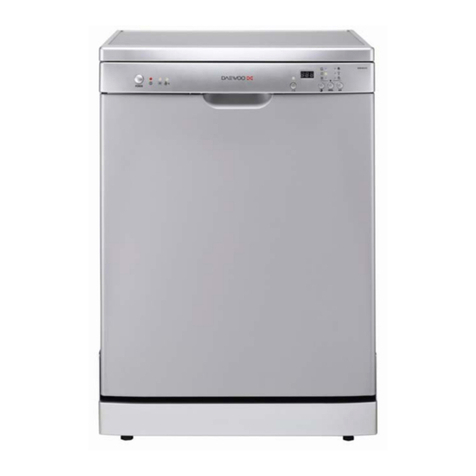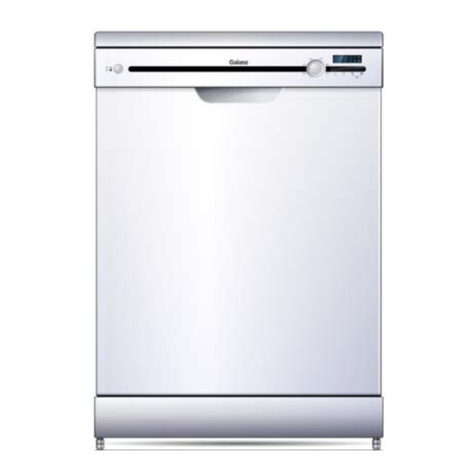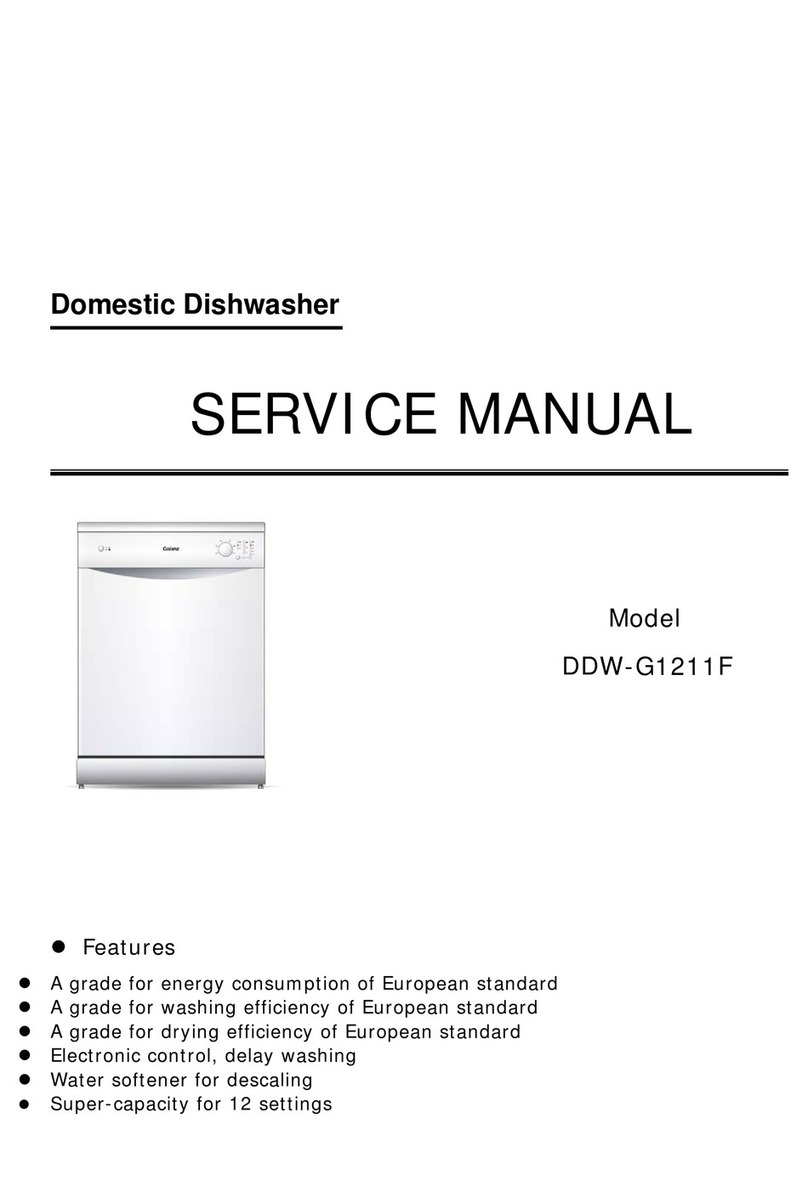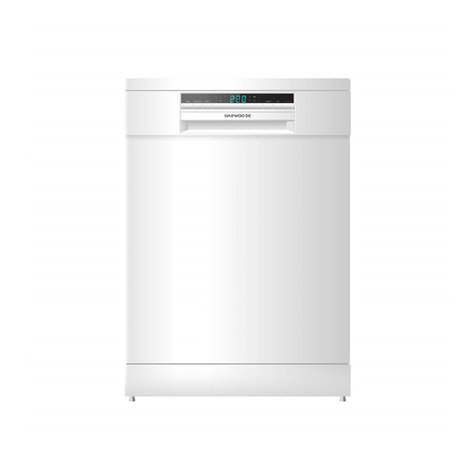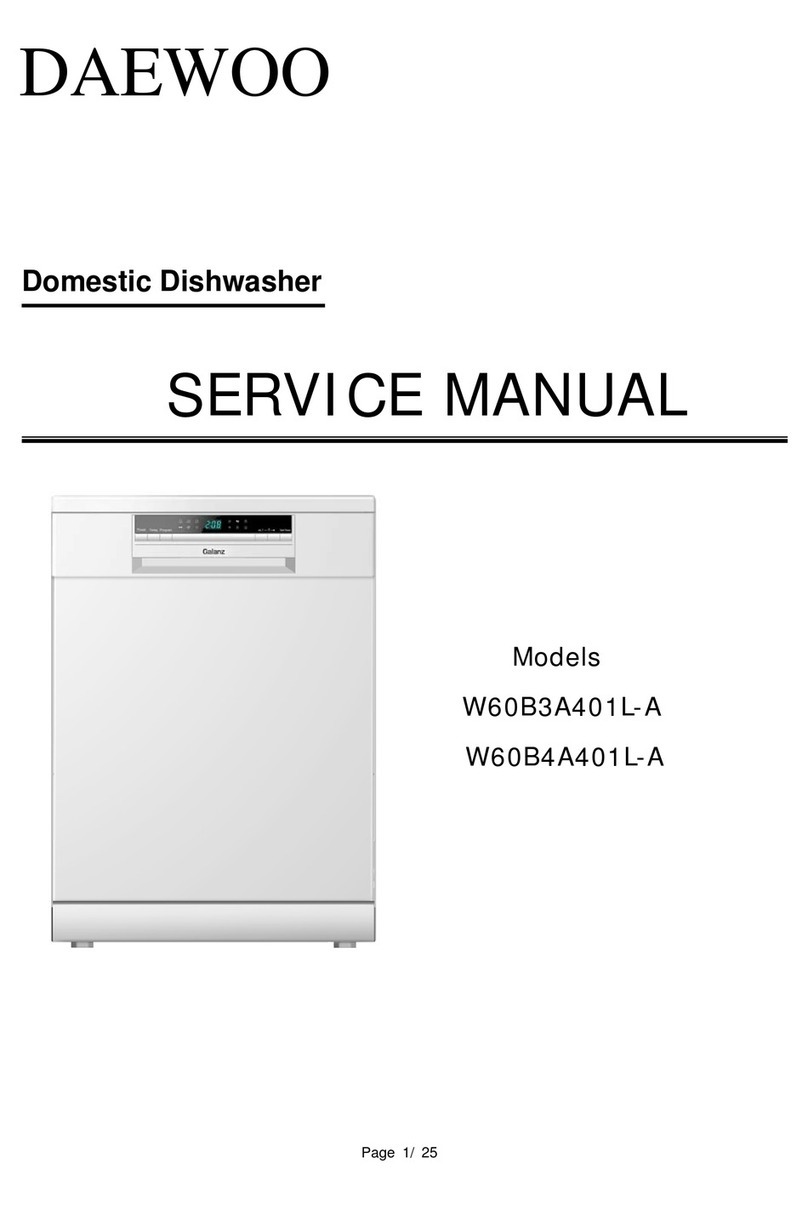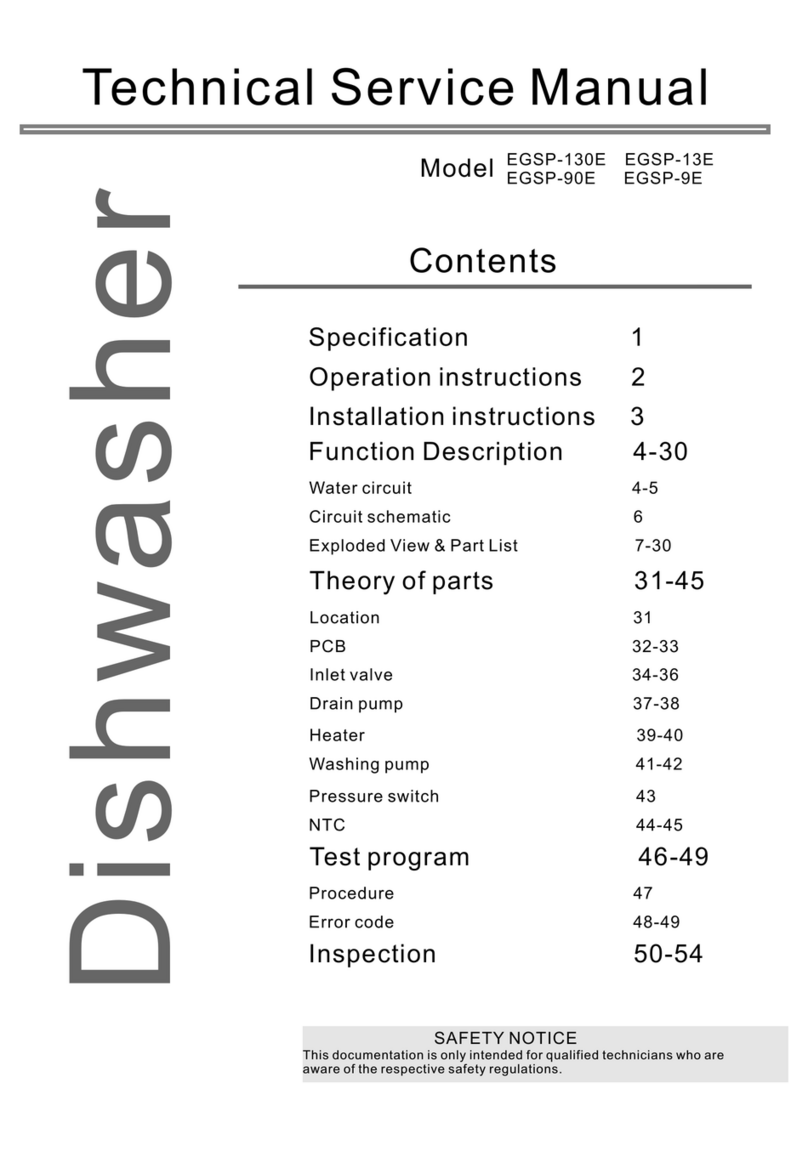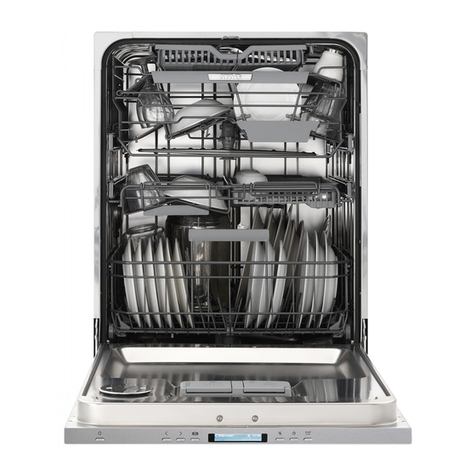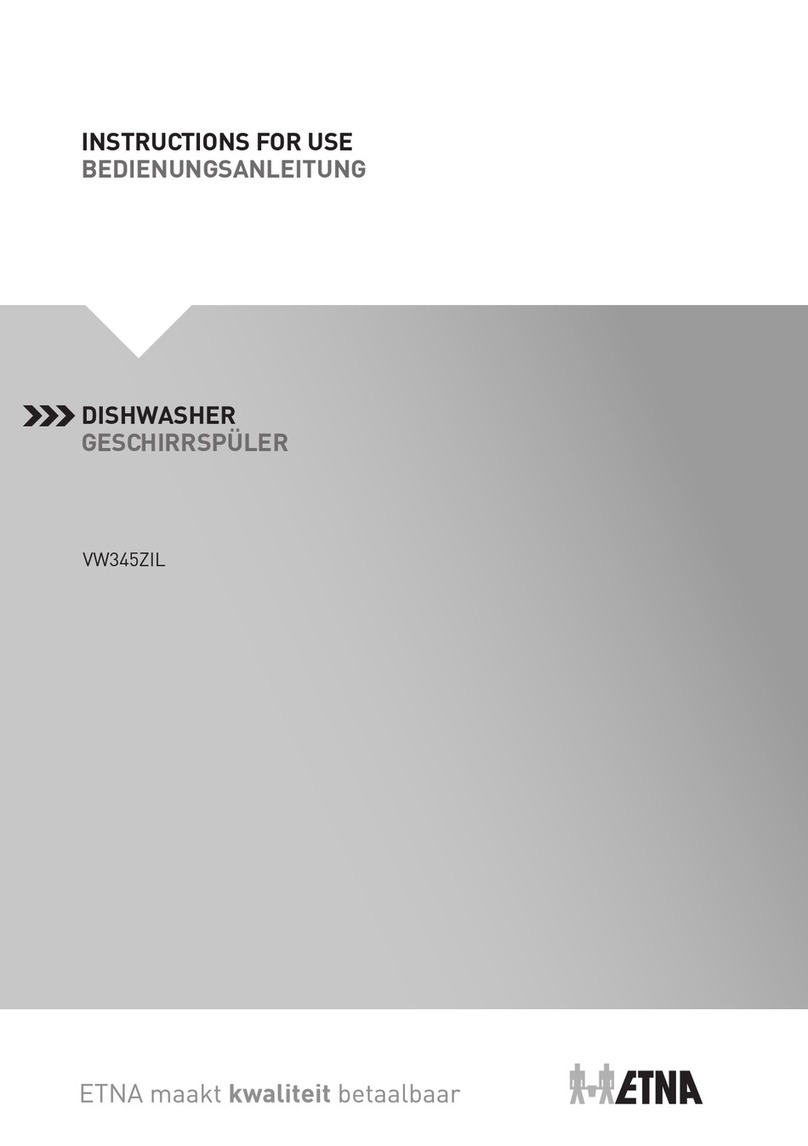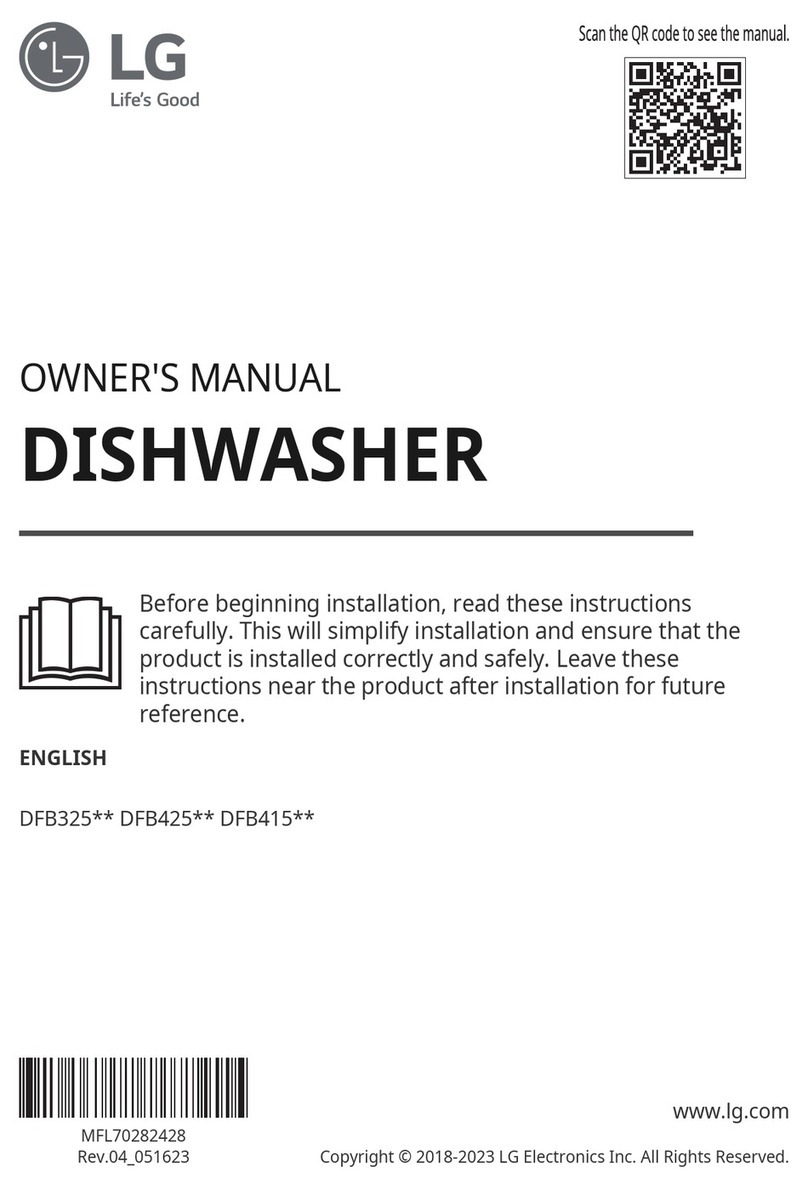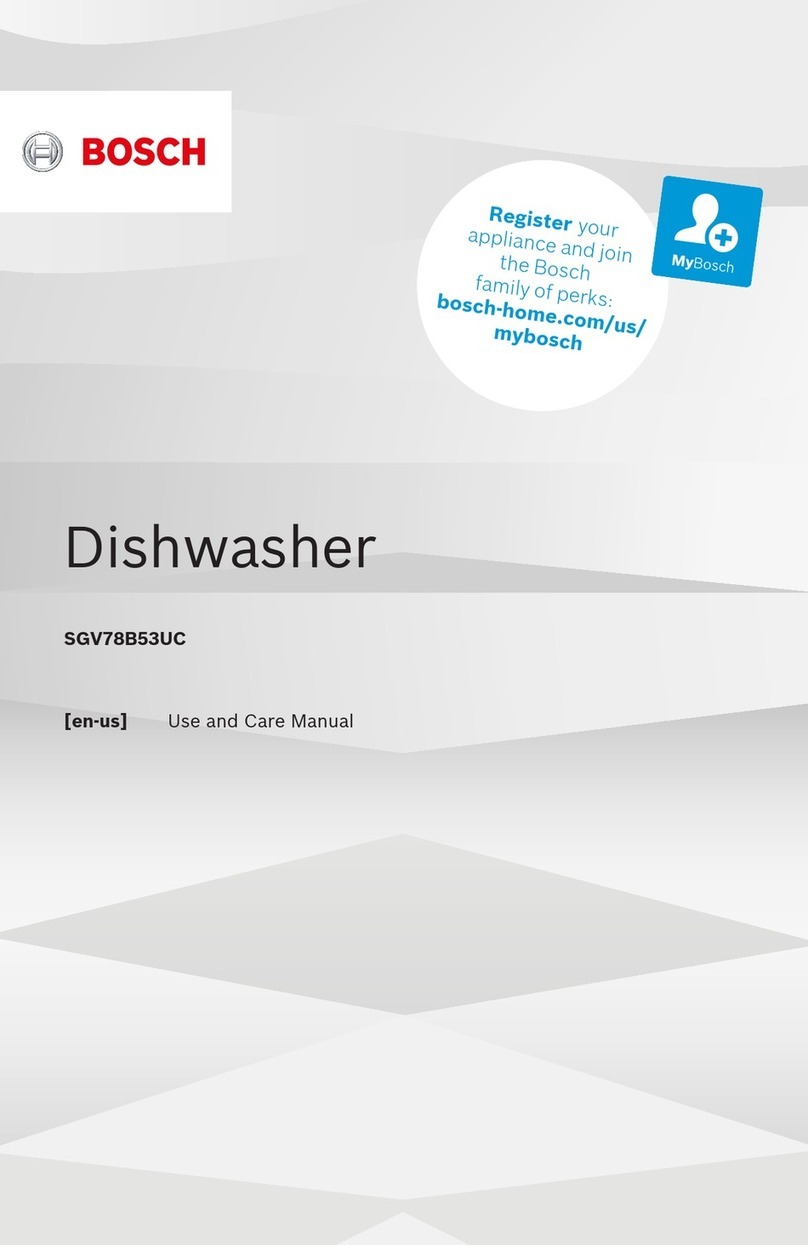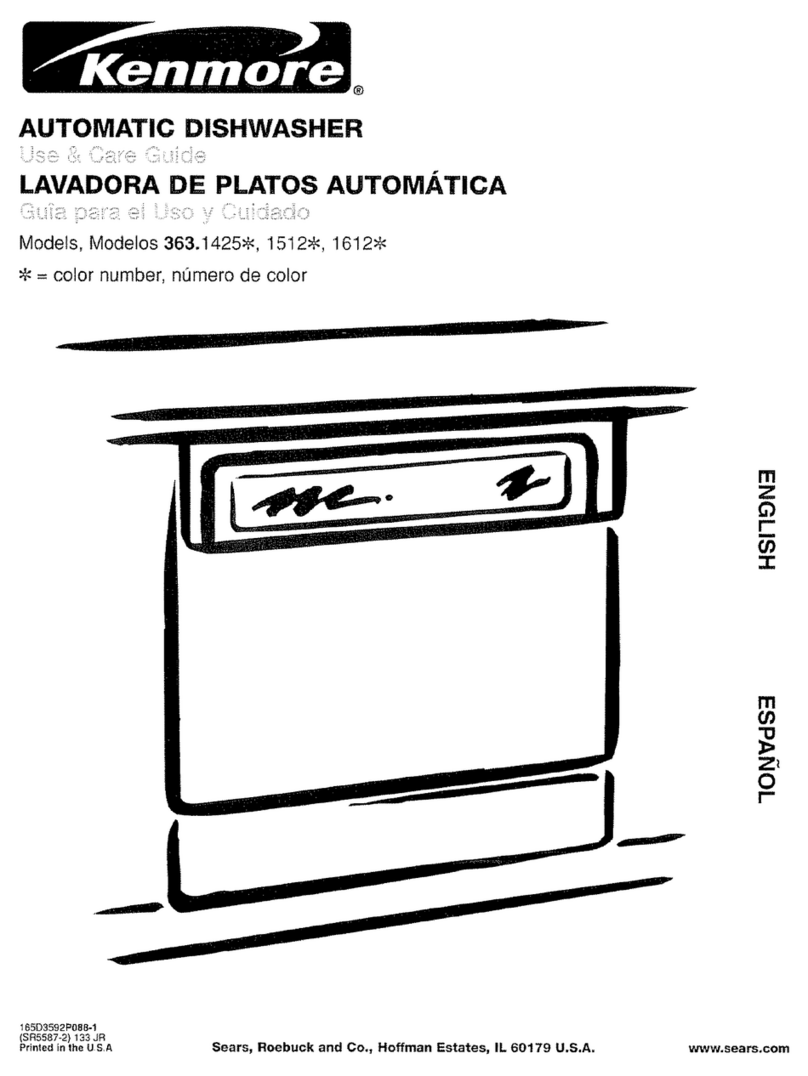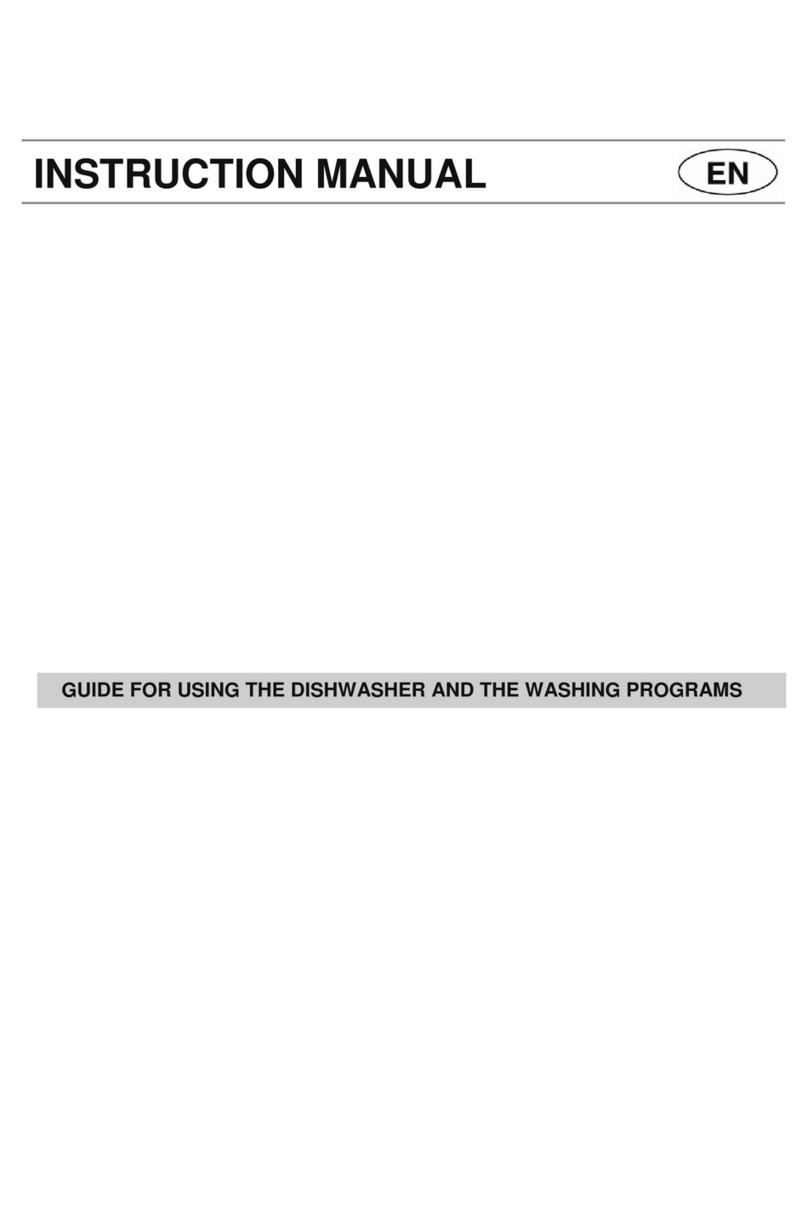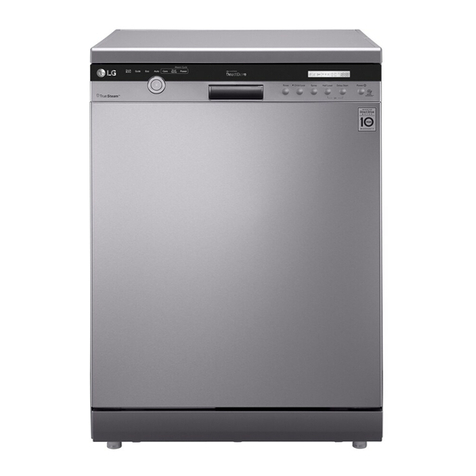Daewoo DDW-M1215 User manual


Witheachwashcycle.
Compartment
For programmes with pre-wash only.
(Follow the user instructions!)
Electric indicator on control panel (if provided).
Check the rinse aid level
(On models with water softener system only.)
Electric indicator on control panel (if provided).
If there is no salt warning light in the control panel
(for some models), you can estimate when to fill the salt into
the softener by the number of cycles the dishwasher has run.
Check the regeneration
salt level
Load the baskets
Select a programme
Close the door, turn on the water tap and press the Start/Pause button. The machine will start working
after about 10 seconds.
Running the dishwasher
Switch off the appliance
Turn off the water tap,
unload the baskets
Fill the detergent dispenser
Warning: wait a few minutes(about 15 minutes) before unloading the dishwasher to avoid handling
the dishes and utensils while they are still hot and more susceptible to break.
They will alsodry better.Unload the appliance, starting from the lower basket.
Changing the programme
Add forgotten dishes in the
dishwasher.
Scrape off any large amount of leftover food. Soften remnants of burnt food in pans,
then load the baskets. Refer to the dishwasher loading instructions.
Press the Programme button until the selected programme lights up.
( See the section entitled Operationg instruction )“”
When the working cycle has finished, the buzzer of the
dishwasher will sound 8 times, then stop.
Turn off the appliance using the power switch button.
If the appliance is switched
off during a wash cycle.
Open the door carefully.
Hotsteammay escape
when thedooris opened!
If the appliance is switched off during a wash cycle, when switched
on again, please re-select the washing cycle and operate the dishwasher
according to the original Power-on state ).
Switch on the appliance Press the Power button to switch on the appliance, Open the door.
For detailed operating method read the corresponding content onthe instruction manual.
1. Arunning cycle can only be modified ifit has been running for a short time. Otherwise the detergent
may have already been released and the water already drained. If this is the case, the detergent
dispenser must be refilled.
2. Press the Start/Pause button then press the program button for more than 3 seconds to cancel the
running programme.
3. Select a new programme.
4. Restart the dishwasher.
1.Press the start/pause button to stop the machine.
2.Open the door.
3.Add the forgotten dishes.
4.Close the door, then press the start/pause button, the dishwasher will
start running again after 10 seconds.

To review the section on troubleshooting Tips
will help you to solve some common problems
by yourself .
Dear Customer,
Please carefully readthismanualbefore usingthe
dishwasher,it will help you touseand maintain the
dishwasher properly.
Pass it on toanysubsequent owner ofthe appliance.
Thismanual contains sections on safety Instructions,
Operating Instructions, InstallationInstructionsand
Troubleshooting Tips, etc.
The manufacturer, following a policy of constant
developmentandupdating of the product, may
make modifications without giving prior notice.
Keep it as arefer in the later days.
If you can not solvethe problems by yourself ,
please ask for the help of professional technicians.
This appliance is intended tobe used in household
andsimilarapplications suchas:
-staff kitchen areas in shops,offices and other
working environments;
-farm houses;
-byclients inhotels, motels and otherresidential
type environments;
-bed and breakfast type environments.
Dishwasher Features.................................... ...3
A Water Softener...........................................4、
Attention before orafter loading the Dishwasher
Baskets..........................................................9
FilteringSystem.............................................13
Caring for the Dishwasher..................... .........14.
B Loading the Salt intotheSoftener.................5、
C Fill theRinseAid Dispenser.........................5、
D FunctionofDetergent .................................6
、
WashCycleTable...........................................11
Turning on theAppliance................................12
Change the Programme.............. ................12....
At the endoftheWash Cycle...........................12
PositioningtheAppliance................... ..........15..
Water Connection.................................. .......16.
About Power Connection........................ .......15.
Start of dishwasher................................ ......17..
Beforecalling for service........................... .....18.
Errorcodes.................................... ..............19.
Technical information.............................. .....20..
ControlPanel...................................................3
The Method Loading Normal Dishware.............10

This appliance must be grounded. In the event of a
malfunction or breakdown, grounding will reduce
the risk of anelectric shock by providing a path of
least resistance of electric current. This appliance
is equipped with a cord having an equipment-
grounding conductor and a grounding plug.
The plug must be plugged into an appropriate outlet
that is installed and grounded in accordance with
all local codes and ordinances.
Keep children away from detergent and rinse aid, keep
child away from the open door of the dishwasher,
there could still be some detergent left inside.
ren
Donotabuse,siton,orstandonthedoorordish
rack of the dishwasher.
Do not touch the heating element during or
immediately after use.
(This instruction is only applicable to machines
with a visual heating element.)
Do not wash plastic items unless they are marked
dishwasher safe or the equivalent. For plastic items
not so marked, check the manufacturer's
recommendations.
Use only detergent and rinse additives
designed for an automatic dishwasher.
Never use soap, laundry detergent, or hand
washing detergent in your dishwasher. Keep
these products out of the reach of children.
During installation, the power supply must not
be excessively or dangerously bent or flattened.
Do not tamper with controls.
Do not place any heavy objects the
door when it is open. The appliance could tip
forward.
on or stand on
When loading items to be washed:
1) Locate sharp items so that they are not likely
to damage the door seal;
2 Warning: Knives and other utensils with
sharp points must be loadedin the basket
with their pointsdown or placed in a
horizontal position.
)
When using your dishwasher, youshould
prevent plastic items from coming into contact
with the heating element.(This instruction is only
applicable to machines with a visual heating
element.)
Ifthesupplycord isdamaged, it must bereplaced
bythemanufactureroritsserviceagentora
similarly qualified person in order to avoid a
hazard.
Please dispose of packing materials properly.
Use the dishwasher only for its intended function.
Remove the door to the washing compartment when
removing an old dishwasher from service or discarding it.
Dishwasher detergents are strongly alkaline, they
can be extremelydangerous if swallowed.Avoid
contact with skin and eyes and keep children away
from the dishwasher when the door is open.
Check that the detergent comparment isempty
after completion of thewash cycle.
The appliance is to be connected to the water
mains using new hose sets and that old hose-sets
should not be reused.
The maximum number of place settings to be
washed is14.
The maximum permissible inlet water pressure is
1Mpa.
The minimum permissible inlet water pressure is
0.04Mpa.
Children should be supervised to ensure that they do
not play with the appliance.
This appliance is not intended for use by persons
(including children with reduced physical, sensory or
mental capabilities, or lack of experience and
knowledge ,unless they have been given supervision
or instruction concerning use of the appliance by a
person responsible for their safety.
)
When using your dishwasher, follow the precautions listed below:
The door should not be left open,
since this could increasethe riskof tripping.
Improper connection of the equipment-grounding
conductor can result in the risk of an electric shock.
Check with a qualified electrician or service
representative if you are in doubt whether the
appliance is properly grounded. Do not modify the
plug provided with the appliance; If it does not fit
the outlet. Have a proper outlet installed by a
qualified electrician.
Do not operate your dishwasher unless all
enclosure panels are properly in place. Open
the door very carefully if the dishwasher is
operating, there is a risk of water squirting out.

Dispose of the dishwasher packaging material correctly.
All packaging materialscanbe recycled.
Plastic parts aremarked with thestandard international abbreviations:
PE for polyethylene, e.g. sheet wrapping material
PS for polystyrene,e.g.padding material
POM polyoxymethylene, e.g. plastic clips
PP polypropylene, e.g. Salt filler
ABS Acrylonitrile Butadiene Styrene, e.g.Control Panel .
Packaging material couldbedangerous for children!
Fordisposing ofpackage and the appliance please goto arecycling centre. Therefore cut
off the powersupplycable and makethe doorclosingdevice unusable.
Cardboard packaging is manufactured from recycled paper and shouldbe disposedin the
waste paper collection for recycling.
By ensuring this product is disposed of correctly, you will help prevent potential negative
consequences for the environment and human health, which could otherwise be caused
by inappropriatewaste handling of this product.
Formoredetailed informationabout recyclingof this product, please contact your local
city office and your household waste disposal service.
DISPOSAL: Do not dispose this product as unsorted municipal waste. Collection of such
waste separately for special treatment is necessary.

beforeusing it forthe first time.
To getthe best performance from your dishwasher, read all operating instructions
Program indicators: to show which program you
have chose;
11 12
Back View
1
2
3
4
5
7
8
910
Front view
Lower basket
Salt container
Dispenser
Cupshelf
Spray arms
Filter assembly
Inlet pipe connector
Drain pipe
Upperbasket
Cutlery rack
Top spray arm
1
Innerpipe
5
6
7
8
9
10
12
11
3
24
6
PowerButton: Toturnon/off the powersupply.
Program Button :To Press the button to select
appropriate Program.
1.
11.
8.
7. Alt Button: Dual zone wash function, press the button
to select either upper basket or lower basket loaded, and
the response indicatorwill blinking.
9.
DelayButton :To Press the button to delay. Start /Pause button:To start the selected
washing program orpause the washing program
when themachine is working.
3.
12.
Salt warning lights: To show when the salt container
need to be ref illed.
rinse aid warning lights:To show when the
dispenser need to be ref illed.
Display screen: to show thedelay t ime ,remain
t ime ,or error codes indicator.
4.
2.
Child lock button: press the two buttons for3 seconds
simultaneously to lock the program.
10.
Child lockindicator.
6.
SprayArms indicators : to show whick spray arms
willwork.
5.

The water softener must be set manually, using the water hardness dial.
The water softener is designed to remove minerals and salts from thewater, which would have
a detrimentalor adverse effect on the operation of the appliance.
The higher the content of these minerals and salts, the harder your water is.
The softener should be adjusted accordingto the hardness of the waterin your area. Your local WaterAuthority
can advise you onthehardnessofthewaterinyour area.
Adjusting Salt Consumption
The dishwasher isdesigned toallow for adjustmentin the amount of salt consumed based onthe hardness of
thewaterused.This is intended tooptimise andcustomisethelevel of salt consumption.
WATER SOFTENER
Thehardness ofthe watervariesfrom place to place. If hard water is used inthe dishwasher, deposits will
form on the dishesand utensils.
The appliance is equipped with a special softener that uses a salt container specifically designed to eliminate
lime and minerals from the water.
Contact your local water board for information on the hardnessof your water supply.
Please follow the steps below for adjustment in saltconsumption.
If your model does not have any water softener, you mayskip this section.
Clark: British degree
fH: French degree
DH: German degree
dH=1.25Clarke=1.78fH=0.178mmol/l
1
The manufactory setting: H4 (EN 50242)
Before using your dishwasherfor the first time:
A. Set the water softener
B. Add 1.5Kgdishwasher salt and then full fill the salt container with water
C. Filltherinseaiddispenser
D. Fill in detergent
1. Switch on the appliance;
4. Press the On/Off button or no operation for 5 seconds to end the set upmodel.
2. Press the Start/Pause button for more than 5 seconds to start the water softener
set model within 60seconds after the appliance was switched on;
3. Press the button to select the properset according to
your local environment, the sets will change in the following
sequence: H1->H2->H3->H4->H5->H6;
Start/Pause
dH mmol/l
0~90~5 0~0.94 H1 0/
10-20
6-11
1.0-2.0 H2 20 60
21-30
12-17 2.1-3.0 H3 30 50
H4 40
40
fH
0~6
7-14
15-21
Clarke
WATER HARDNESS
SelectorPosition Salt consumption
(gram/cycle) Auto nomy
(cycles/1kgs)
18-22 31-40 22-28 3.1-4.0
41-60
23-34 4.1-6.0 H5 50 30
H6 60 20
29-42
35-55 61-98 43-69 6.1-9.8

1. The salt container must only be refilled when the salt warning light in the control panel comes on.
Depending on how well thesalt dissolves, thesalt warninglight maystill be on even though the
salt container is filled.
If there is no salt warning light in the control panel (forsome Models),you can estimate whento fill
the salt into the softener by the cycles that the dishwasherhas run.
2. If thereare spills ofthe salt,a soak or a rapid program should be run to remove the excessivesalt.
Always use the salt intended for use with dishwasher.
The salt container is located beneath the lower basket and should be filled as explained
inthe following:
Attention!
Only use salt specifically designed for the use indishwashers! Every other type of
salt not specifically designed for the use in adishwasher, especially table salt, will
damage thewater softener. In case of damages caused by the use of unsuitable
salt the manufacturerdoes not give anywarranty nor is liable for any damagescaused.
Only fill withsalt justbefore startingone of the complete washingprograms.
This will prevent any grains of salt or salty water, which may have been spilled,
remaining on the bottomofthe machinefor any period oftime, which maycause
corrosion.
The rinse aid isreleasedduringthe final rinse to prevent water from forming droplets onyour dishes, which can
leave spots and streaks. It also improvesdrying by allowing watertoroll offthe dishes. Your dishwasher is
designed touseliquid rinseaids.The rinseaid dispenser islocated inside thedoor next to thedetergent dispenser.
To fill the dispenser, open the cap and pour the rinse aid into the dispenser until the level indicator turns completely
black. The volume ofthe rinseaidcontainer is about 110ml.
RinseAid Dispenser
Function of RinseAid
Rinse aid is automatically added during thelastrinse, ensuring thorough rinsing, and spotandstreakfree drying.
Attention!
Only use branded rinse aid for dishwasher. Neverfill therinse aid dispenser withanyothersubstances
(e.g. Dishwasher cleaning agent, liquid detergent).This would damage the appliance.
3.If the machine needs to be dumped for the reasons of transit, repairandso on, please usethebibulous cloth or
analog toblotup thewaterin the salt container,andscrew thecaptightly,afterward, transitor repair themachine.
Aftertransiting or repairing themachineandconfirmingit in order, load the salt into the softeneraccordingto the
processof B. Loading the salt intothe Softener .Otherwise, it could bemake the big damage to the machine,for
example, rustiness,conk and so on. Such problems areout of theguarantee range.
“”
Full fill the saltcontainer withwater,Itisnormal for asmall amount ofwatertocome outofthe
salt container.
AAfter the lower basket has been removed, unscrew and remove the cap from the salt container.
C
DAfter filling the container , screw the cap tightly back clockwise.
EThe saltwarning lightwillstop being after thesalt container has beenfilled withsalt.
FImmediately afterfilling the salt into the salt container, a washing program should be started
program Otherwise the filter system, pumpor other important parts of the machine maybe damaged
bysalty water.This isoutofwarranty.
(Wesuggest to use a short
).
BPlace the end ofthefunnel (supplied) into the hole and introduce about 1.5kg of dishwasher salt.

To open the dispenser,turn the cap to the "open" (left) arrow and lift it out.
Pourthe rinse aid intothe dispenser, being careful not tooverfill.
Replace the cap by inserting italigned with "open" arrow and turning it tothe closed (right) arrow.
Adjusting RinseAid Dispenser
The rinse aid dispenser has six or four settings.Always start with the dispenser
set on "4". If spots and poor drying are a problem, increase the amount of rinse
aid dispensedby removing the dispenser lidand rotating the dial to "5".If the
dishes still are not drying properly or are show spots, adjustthe dial to the next
higher lever until your dishes are spot-free. The recommended setting is "4".
(Factory valueis "4".)
Increasethe dose if thereare drops of waterorlimespots onthe dishes after washing.
Reduce itif there are sticky whitish stains on your dishes ora bluish film on glassware or
knife blades.
1
2
3
As the rinse aid diminishes, the size of the black dot
ontherinse aidlevel indicator changes, as illustratedbelow.
Full
3/4full
1/2full
1/ 4full -Should refillto eliminate spotting
Empty
When to Refill the RinseAid Dispenser
Ifthereis no rinse-aid warning lightin thecontrolpanel, you can estimate the amount from the colour
of the optical level indicator C located next to the cap. Whenthe rinse-aidcontainer isfull, the whole
indicator will be dark .As the rinse-aid diminishes, thesize of the dark dot decreases. You should never let
the rinse aid level fall 1 / 4 full.
during the nextwash.
Don'tforget to replace the cap before you closedishwasherdoor.
Clean up any rinse aid spilled while during filling with an absorbent cloth to avoid excessive foaming
Detergents with its chemical ingredients arenecessary to remove dirt, crushdirt and transport it outof the dishwasher.
Mostof the commercial qualitydetergents are suitable for this purpose.
""
Proper Use ofDetergent
Useonly detergent specificallymade for the use in dishwashers. Keep your detergent fresh and dry.
Don't putpowdereddetergentintothe dispenseruntil you're ready to wash dishes.
Attention!

Amount of DetergenttoUse
Dishwasher detergent is corrosive! Take care to keepit out of reach of children.
Based ontheir chemical composition, detergentscan besplitin two basictypes:
The use of normal washing programs in combination with concentrated detergents
reduces pollution and is good for your dishes; these wash programsare specifically matched
to the dirt-dissolving properties of the enzymes of the concentrated detergent. For this reason
normal wash programsin which concentrated detergents areused canachievethe same
results that can otherwise onlybe achieved using intensive programs.
“”
“”
“”
Detergent tabletsofdifferent brandsdissolve at different speeds. For this reasonsome
detergenttablets cannot dissolve and develop their fullcleaning power during short
programs. Therefore please use long programs when usingdetergent tablets, to
ensure the complete removal of detergent residuals.
The dispenser mustberefilled before the start of each washcycle following the instructions
provided in the wash cycle table . Your dishwasher uses less detergent and rinseaid than
Conventional dishwasher.Generally, only one tablespoon of detergent is neededfor
anormal washload. Moreheavily soileditems needmore detergent.Alwaysaddthe
detergentjust before starting the dishwasher, otherwiseit couldget damp and willnot
dissolve properly.
Concentrated Detergent
DetergentTablets
DetergentDispenser
conventional, alkaline detergents with caustic components
low alkaline concentrated detergents with natural enzymes
Normally new pulverised detergent is without phosphate.Thus the watersoftener function of
phosphate is not given. In this case we recommend to fill salt in the salt container even when
the hardness of water is only 6 dH. If detergentswithout phosphate are used in the case of hard water
often white spots appear on dishes and glasses. In this case please add more detergent to reach
better results. Detergents without chlorine do only bleach a little. Strong and coloured spots will not
be removed completely. Inthis case pleasechoosea program with a higher temperature.
°
Detergents
There are 3 sorts of detergents
1.Withphosphate andwithchlorine
2.With phosphate andwithout chlorine
3.Withoutphosphate and without chlorine
Always add the detergent just before starting each wash cycle.
Only use branded detergentaidfor dishwasher.
If the lid isclosed: press release button. The lid will spring open.
Detergent tablet
Detergent powder

Fill the detergent dispenser with detergent.
The marking indicates the dosing levels , as
illustrated on the right:
Theplaceof main wash cycledetergent placed.
Theplace of pre-washcycle detergent placed.
Please observe the manufacturers dosing and storage
Recommendations asstatedonthedetergent packaging.
Close thelid and press untilit locks in place.
If the dishes are heavily soiled, place anadditional
detergent dose in the pre-wash detergent chamber. This detergent will take effectduring the pre-washphase.
A
B
Fill in Detergent
You find information about the amount ofdetergent for thesingle programme onthe last page.
Pleaseaware, that according tothe levelsoiling and the specific hardnessof water differencesarepossible.
Pleaseobservethemanufacturer's recommendations onthe detergent packaging.

Cutlery with wooden,horn china or
mother-of-pearl handles
Plasticitems that arenotheat resistant
Older cutlerywith glued partsthat are not
temperatureresistant
Bonded cutlery items or dishes
Pewter or cooper items
Crystal glass
Steel items subject to rusting
Wooden platters
Items made fromsynthetic fibres
Some types of glassescan become
dull aftera large number of washes
Silver and aluminum parts have a
tendency to discolourduring washing
Glazed patterns may fade if machine
washed frequently
Are not suitable Are oflimited suitability
Dishes and itemsof cutlery mustnotlie insideoneanother, or cover each other.
To avoiddamage to glasses,theymust not touch.
Load large itemswhich are most difficult to clean intothe lower basket.
The upper basket is designed to holdmoredelicate and lighterdishware such as glasses, coffee
andteacups
Long bladed knives stored in an uprightposition are a potential hazard!
Long and/or sharp itemsof cutlery such as carving knives must be positioned
horizontallyin the upperbasket.
Please do not overload your dishwasher. This is importantfor goodresultsandfor
reasonable consumption of energy.
Load hollow items such as cups,glasses, pans etc. With the opening facing downwards so that
water cannot collect in the container or a deep base.
Consider buying utensilswhich are identifiedas dishwasher-proof.
Usea mild detergentthatisdescribedas 'kind to dishes'. Ifnecessary, seekfurther
information from the detergent manufacturers.
Forparticular items, select a programwithas low a temperature aspossible.
To prevent damage, do not take glassandcutlery out of the dishwasher immediately
after the programmehas ended.
(For best performance of the dishwasher, follow these loading guidelines.
Features and appearance of baskets and cutlerybasketsmay vary from your model.)
Scrape off any largeamountsof leftover food. Soften remnants of burnt food inpans.
It is not necessary to rinse the dishes under running water.
Place objects in the dishwasher in following way:
1.Items such as cups, glasses, pots/pans, etc. are faced downwards.
2.Curved items, or ones with recesses, should be loaded aslant so that water can run off.
3.All utensils are stacked securely and can not tipover.
4.All utensils are placed in the way thatthe spray arms can rotate freely during washing.
Very small items should not be washed in the dishwasher as they could easily fall out of the basket.
To prevent water dripping from the upper basket into the lower basket, we recommend that you
empty the lower basket first and then the upper basket.

Theupper basket is designed to hold more delicate
and lighter dishware such as glasses, coffee and
teacups and saucers, as well asplates,small bowls
andshallowpans (as long astheyare not too dirty).
Position thedishes andcookware so thatthey will
notgetmoved bythe spray ofwater.
We suggest that you place large items and the most
difficultto cleanitemsareto be placedintothelower
basket: suchas pots, pans, lids, serving dishes and
bowls, as shown in the figure below. It is preferable to
place serving dishes and lids on the side of the racks
in order to avoid blocking the rotation of the top spray
arm.
Pots,servingbowls,etc,mustalwaysbeplacedtopdown.
Deep pots should be slanted to allow water to flow out.
Please bereminded that:
The Bottom Basket features folding spikes so that larger or more pots and pans can be loaded.
Folding Spikes of Lower Basket
Forbetter stacking of pots and pans,
the spikescan be folded down as
show in the picture right.
Adjusting the Upper Basket
The heightof the upperbasketcan be adjusted in order to
create morespace for largeutensilsbothfor the upper
/lowerbasket. The height of the upper basket canbe
adjusted byplacing thewheels on different heightofthe
rails. Long items, serving cutlery, salad servers and knives
shouldbeplaced ontheshelf sothat theydonotobstruct
therotationofthesprayarms..
Folding back the cup shelives
For better stacking of pots andpans,
the spikes can be folded down as
show in the picture right.
Cutleryshouldbe placed inthecutlery rackseparately
from each other in the appropriate positions, and do
make sure the utensils do not nest together, this may
causebadperformance.

Starting a cycle wash
Draw out the lower and upper basket, load the dishes and push them back.
Itiscommended to load thelower basket first, then the upper one (see the section entitled
Loadingthe Dishwasher ).
Pour in the detergent (see the sectionentitled Salt, Detergent and RinseAid ).
Insertthe pluginto the socket.The power supply is 220-240 VAC /50 HZ, the specification
of thesocket is 10A 250VAC. Makesure that the water supply is turned on to full pressure.
Close the door, press the P button to switch on the machine.
Press the program button , the wash program will be changed asfollows direction:
If a program is selected, the response light will light. Then press the Start/Pause button, the
dishwasher beginsto start.
“”
“”
ower
Intensive->Normal->ECO->60min->Rapid ;->Soak
1
2
3
4
5
Means: need to fill rinse into the Rinse-Aid Dispenser.
()
*EN 50242 : Thisprogramme is the test cycle. The information for comparability test
in accordance with EN 50242,as follows:
Capacity: 14 setting
PositionUpper basket: upper wheels onrails
Rinse aid setting: 6
Pl:0.49w; Po:0.45w.
Intensive
Normal
(*EN 50242)
(or )3in1
5/30g
(or )3in1
5/30g
(or )3in1
5/30g
Rapid
Pre-wash (50 )
Main wash(65 )
Rinse
Rinse
Rinse (55 )
Drying
℃
℃
℃
Pre-wash (45 )
Wash (50 )
Rinse
Rinse (60 )
Drying
℃
℃
℃
Pre-wash
Wash (50 )
Rinse
Rinse (60 )
Drying
℃
℃
Wash (40 )
Rinse
Rinse (45 )
℃
℃
180
175
165
40
1.2
0.93
1.5
0.6
17
14
10
10
60 min
Pre-wash (50 )
Wash (60 )
Rinse (60 )
Drying
℃
℃
℃60 10
1.15
5/30g
20g
Soak
Rinse
80.01
3.5
Glass
115 14
0.87
5/25g
Pre-wash
Wash (40 )
Rinse
Rinse (60 )
Drying
℃
℃
Fornormallysoiled loads,
such as pots plates glasses
and lightly soiled pans.
、、
For heaviest soiled crockery,
and normally soiledpots
pans dishes etc with dried
onsoiling;
、
、
tFor lightlysoiled loads hat
do not need excellentdrying
efficiency.
Ashorter wash for lightly
soiled loads andquick wash
To rinse dishes that youplan
to wash laterthat day
For lightlysoiled crockery
and glass
This isstandard programme,
it is suitable to clean normally
soiled tableware andit isthe
most efficient programme in
terms ofits combined energy
andwaterconsumption for
that type of tableware.

When the working cycle has finished, the buzzer of the dishwasher will sound for8 seconds, then stop. Turn off
the appliance using the Power switch button, shut off the water supply and open the door of the dishwasher.
Wait for afew minutes before unloading thedishwasher to avoidhandlingthedishes and utensilswhile they
are still hot and more susceptible to breakage. They will also dry better.
Switch Off the Dishwasher
The program light is on but is not blinking, only in this case the programmehas ended.
Power1.Switch off the dishwasher by pressing the button.
2.Turnoffthewatertap!
Open the door carefully.
Hot dishes are sensitive to knocks. The dishes should thereforebe allowedto cool down around 15 minutes
before removing from the appliance.
Open thedishwasher's door, leave it ajar and wait a few minutes before removing the dishes. In this way they
will be cooler andthe drying will be improved.
Unloadingthe dishwasher
It is normal that the dishwasher is wet inside.
Empty thelower basket first and then the upperone. This will avoid water dripping from the upper Basket onto
the dishes in the lower one.
If you open the door , the machine will pause. The program lightwill
stop blinking and the buzzer will mooing every minute unless you close the door .After
you close the door ,the machine will keepon workingafter 10 seconds.
during awash cycle
Premise:
1 Acycle that is underway can only be modified if it has only been running for a short time. Otherwise, the
detergent may have alreadybeen released, and the appliancemay have already drained the wash water.
If this is the case, the detergent dispenser must be refilled (see the section entitled "Loading the
Detergent " ).
2 Press the Start/Pause button , the machinewill be in standby state, press the program button more than
3s then you can change the program to thedesired cycle setting (see thesection entitled " Starting awash
cycle. . ." ).
Aforgotten dish can be added any time before the detergent cup opens.
Add forgotten dishes.
Close the door
After the spray arms stop working,you can open the door
completely.
2
3
Open the door a little to stop the washing.
14
5
6
Press the Start/Pause button
Press the button, the dishwasher will run
after 10 seconds.
Start/Pause
When you press the Start/Pause button to pause during washing, the running indicator will
stop blinkingand the dishwasher will mooingevery minute unless youpress the
Start/Pause buttonto start.
Wash thearms in soapy and warm water and use a soft brush to
cleanthejets. Replace them afterrinsing them thoroughly.
When following this procedure from step1 to step 3, the filter system will be removed;
when following it from Step 3 to Step 1, the filter system will be installed.
It is dangerousto open the door when washing, because the hot water may scald you.
If yourmodelhas broken remember function,the machine willgo on to finish the selected
program .
after the powercut

The filter preventslarger remnantsof food or other objects from getting inside thepum.
Theresidues may blockthefilter, inthis casethey must be removed.
The filter system consists of a coarse filter,a flat (Mainfilter)
And a microfilter(Fine filter).
Food and soil particles trapped in thisfilter arepulverizedby a
special jet on the lower spray arm andwashed down todrain.
Larger items, such as pieces of bones or glass, that couldblock
the drainaretrappedin the coarse filter. To remove theitems
caught by the filter, gently squeeze the tap onthetop of this
filterandliftout.
Thisfilter holds soil and food residuesin the sumpareaand
prevents itfrom beingredepositon the dishes during wash cycle.
Main filter
1
Coarse filter
2
Fine filter
3
2
3
1
Filterassembly
Thefilter efficiently
For best performance and results, the filter must be cleaned regularly. this reason, it isa goodidea to
remove thelarger foodparticles trapped in the filteraftereach washcyclebyrinsing the semicircular filter and
cup under running water. To remove the filter device,pull thecup handle in the upwarddirection.
removes food particles fromthe wash water, allowing it to be recycled during the cycle.
For
The dishwasher must never be used without the filters.
Improper replacementof the filter may reduce the performancelevel of the appliance
and damage dishesandutensils.
1
2
Step 1 Turn the filter in anti-clockwisedirection,:
Step 2 lift the filter assy up:
When following this procedure from step1 to step 2, the filter system will be removed;
when following it from Step 2 to Step 1, the filter system will be installed.

The control panel can be cleaned by using a lightly dampened cloth.
After cleaning, make sure to dry it thoroughly.
For the exterior, use agood appliance polish wax.
Never usesharp objects, scouring pads orharsh cleaners onany part ofthe dishwasher.
ProtectAgainst Freezing
1.Cut off the electrical power to thedishwasher.
2.Turn off the water supply and disconnect the water inlet pipe from the water valve.
3.Drain the water from the inlet pipe and water valve. (Use a pan to gather the water)
4.Reconnect the water inlet pipe to the water valve.
5.Remove the filter at the bottomof the tub and use a spongeto soak up water in the sump.
please take frost protection measuresonthe dishwasher in winter.Every fter washingcycles,
please operate as follows time a
:
Cleaning the Filter
CleaningThe Door
To clean the coarsefilter and the fine filter, use a cleaning brush. Reassemble thefilter parts as shown in the figures
on thelast page and reinsert the entire assembly in the dishwasher, positioning it in itsseat and pressing downwards.
When cleaning the filters, don't knock on them. Otherwise, the filters could be
contorted andtheperformance ofthe dishwashercouldbedecreased.
To clean theedge around the door,you should use only a soft warm, damp cloth.
To avoid penetrationof waterinto the door lock and electrical components,do not
use a spray cleaner of any kind.
Never use a spray cleaner toclean the door panel as it may damage the door lock
and electrical components.
Abrasive agentsor some paper towels should not be used because of the riskof
scratching or leaving spots on the stainless steel surface.
Cleaning the SprayArms
If your dishwasher cannot work because of the ice,
please contact professional service persons.
It is necessary to clean the spray arms regularly for hard
water chemicalswillclogthesprayarmjetsandbearings.
- Inspect the filtersfor blocking after every timethe dishwasher has been used.
- By unscrewing the coarse filter, you can remove the filter system. Removeanyfoodremnants and
cleanthefilters underrunningwater.
Remarks:
The entire filter assembly shouldbe cleaned once a week.
Toremove thelowerspray arm, pull out the spray arm upward.
To remove the upper sprayarm, hold the nut, rotate the arm
clockwise toremoveit.
Wash the arms in soapy andwarm water and use a soft brushto
clean thejets. Replace them after rinsingthem thoroughly.

Itisrecommend that yourun awashcycle with the
dishwasher empty andthen remove the plugfrom the
socket, turn off the water supply and leave the door of
the appliance slightly open. This will help the door
sealstolastlonger andpreventodoursfromforming
withinthe appliance.
If the appliance must be moved, tryto keep it in the
verticalposition. Ifabsolutelynecessary,itcanbe
positioned on its back.
Oneofthefactorsthatcauseodourstoforminthe
dishwasher is food that remainstrapped in the seals.
Periodic cleaning with adamp sponge will preventthis
from occurring.
Ensure the voltage and frequency of the power being corresponds to
those on the ratingplate. Only insert the plug into an electricalsocket which is earthed
properly. Ifthe electrical socket to which the appliance must be connected is not
appropriate fortheplug, replace the socket, ratherthan usinga adaptors or thelike as
they couldcause overheating andburns.
Pleaselook at therating label to know the rating voltage and connect the dishwasherto the appropriate powersupply.
Use the required fuse10 amp,timedelay fuse or circuitbreakerrecommended and provide separate circuit serving
only this appliance.
Position the appliance in the desired location. The back should restagainst the wall behindit, and the sides,
along the adjacent cabinets or walls.The dishwasher is equippedwith water supply and drain hoses thatcan
be positioned either tothe rightor the left sides to facilitate proper installation.
Once the applianceis positioned for levelling, the height of the dishwasher
may be altered via adjustment of the screwing level ofthe feet. In any case,
theappliance should not be inclined more than 2 .
For personal safety:
DO NOT USEAN EXTENSION CORD OR AN ADAPTER PLUG WITH THIS APPLIANCE.
DO NOT, UNDERANY CIRCUMSTANCES, CUT OR REMOVE THE EARTHING
CONNECTION FROM THE POWER CORD.
Before cleaning or performing maintenance, always
remove the plug from the socket.
Tocleantheexteriorandrubberparts ofthedishwasher,
donot use solventsor abrasivecleaning products.
Only use acloth with warm soapy water.
To remove spots or stains from the surface of the
interior, use a cloth dampened withwater ana little
vinegar, ora cleaning product madespecificallyfor
dishwashers.
Remove the Plug
No Solvents orAbrasive Cleaning Moving theAppliance
Seals
After every wash, turn off the water supply to the
appliance and leave the doorslightlyopen sothat
moisture and odours arenot trapped inside.
After EveryWash
When not in Use for aLongTime
This appliance must be earthed. In the event of a malfunction or breakdown, earthing will reduce the risk of
electric shock by providing a path of least resistance for the electric current. This appliance is equipped with a
cord having an equipment-earthing conductor and an earthing plug. The plug must be plugged into an
appropriate outlet that is installed and earthed in accordance with all local standards and requirements.

Connect thecold water supply hose to athreaded 3/4(inch) connector and make sure
that it is fastened tightly in place.
If the water pipes are new or have not been used for an extended period of time, let the
water run to make sure that the water is clear. This precautionis needed to avoid the
risk of the water inlet tobe blocked and damage the appliance.
Please close the hydrant afterusing.
for personal safety:
DO NOT USE AN EXTENSION CORD OR AN ADAPTER PLUG WITH THIS APPLIANCE.
DO NOT, UNDER ANY CIRCUMSTANCES, CUT OR REMOVE THE
FROM THE POWER CORD. EARTHING
CONNECTION
Improper connection of the equipment earthing conductor can result in the risk of an
electric shock.
Check with a qualified electrician or service representative if you are in doubt whether the
appliance is properly earthed.
Do not modify the plug provided with the appliance. If the plug does not fit properly to the
outlet, please have a qualified electrician to install a proper outlet.
Insert the drainhose into adrainpipe with aminimum diameter of 40mm,or letit run into the sink, making sureto
avoid bendingor crimping it. The topof the hosemust belessthan 1000mm.
A
Counter
Front
Drain pipe
NOTE
The top of the hose
must be less than
1000mm.
φ40mm
B

The followingthings should be checked before starting the dishwasher.
The content of this manual is very helpfulto theusers.
After installation, please make sure tokeep this manual.
1
The dishwasher is level and fixed properly
2
The inlet valve is open
3
There is a leakage at theconnections of theconducts
4
The wires are tightly connected
5
The power is switched on
6
The inlet and drain hoses are knotted
7
Allpackingmaterials and printings should be taken out fromthe dishwasher
Extension Hose
Ifyouneeda drainhoseextension, make sure tousea similar drain hose.
It must be no longer than 4metres;otherwise the cleaning effectof the dishwasher could be reduced.
Water Outlet
Connect the water drain hose.Thedrain hose must be correctlyfitted to avoidwater leaks.
Ensure that thewater drain hose is not kinked or squashed.
If the sink is 1000 higher from the floor, the excess water in hoses cannotbe drained directly
into the sink.Itwillbe necessary todrainexcesswater from hoses into abowlorsuitable
container that is held outside and lower thanthe sink.
How to Drain Excess Water From Hoses
Syphon Connection
The waste connection must be at a height less than 100 cm (maximum) from the bottom of the dish.
The waterdrain hose should be fixed .
Table of contents
Other Daewoo Dishwasher manuals
Popular Dishwasher manuals by other brands
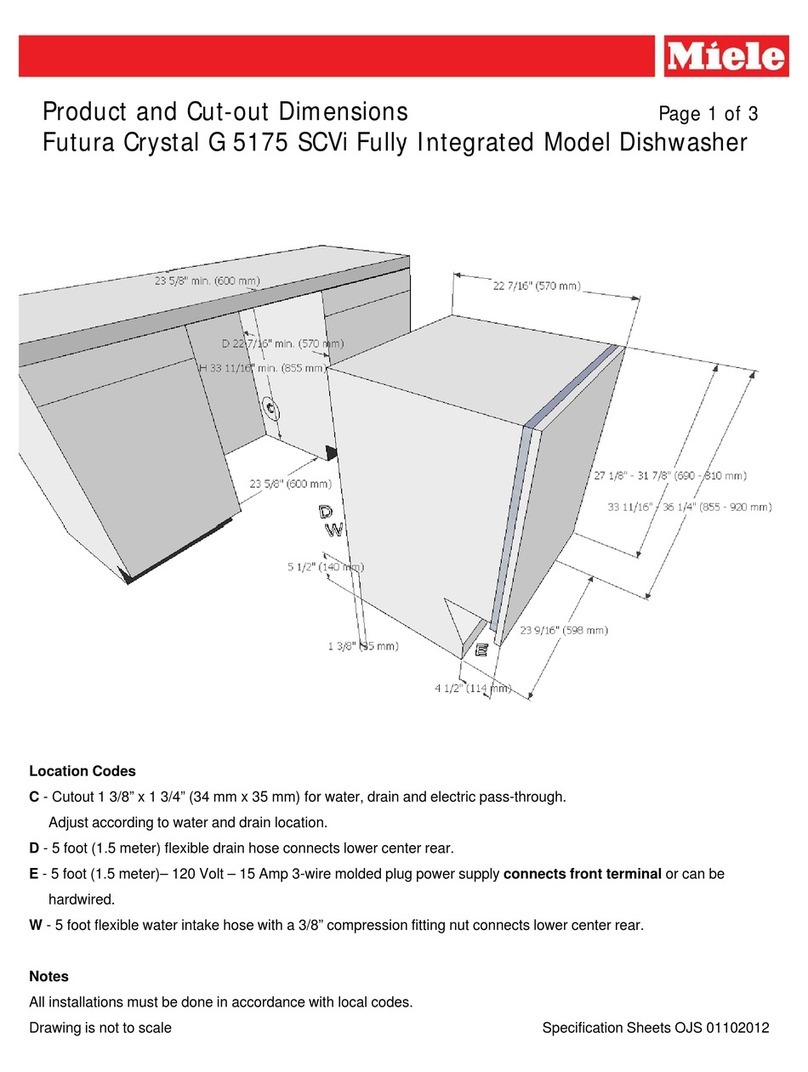
Miele
Miele Futura Crystal Crystal G 5175 SCVi Product dimensions

KitchenAid
KitchenAid W10216167A installation instructions
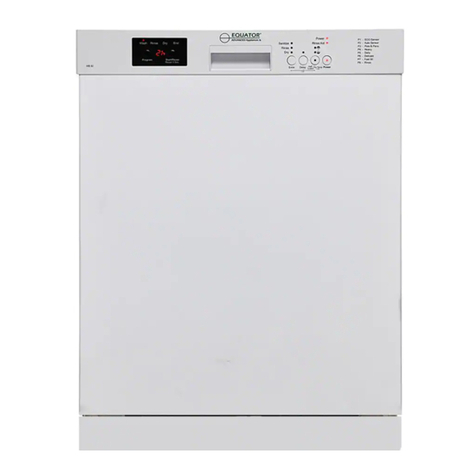
Equator
Equator WB 82 owner's manual
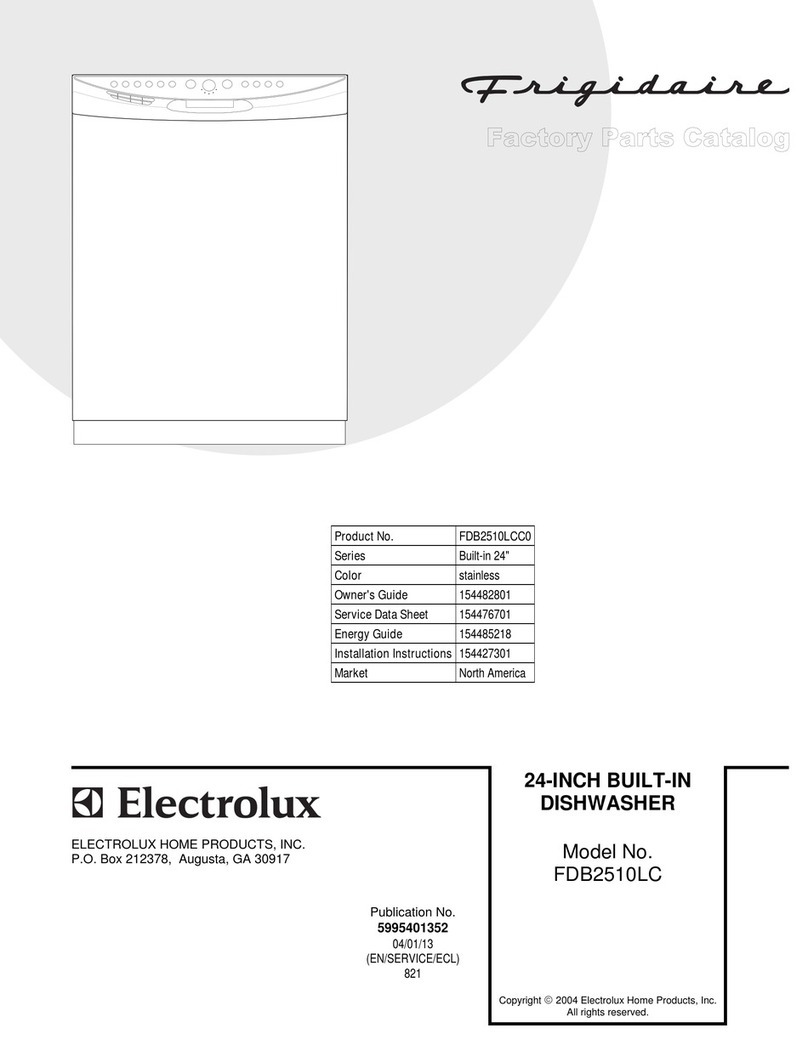
Frigidaire
Frigidaire FDB2510LC Factory parts catalog

Kenmore
Kenmore ULTRA WASH 665.1388 Series Use & care guide
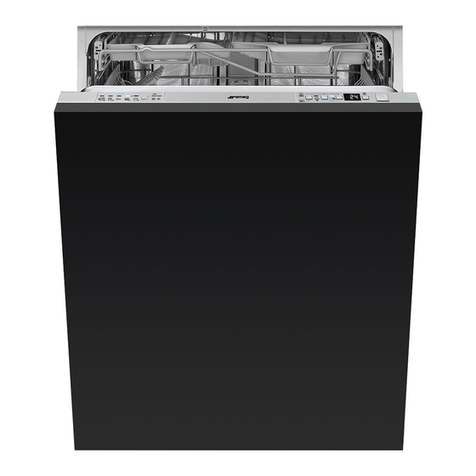
Whirlpool
Whirlpool ADG 7470 Quick reference guide
